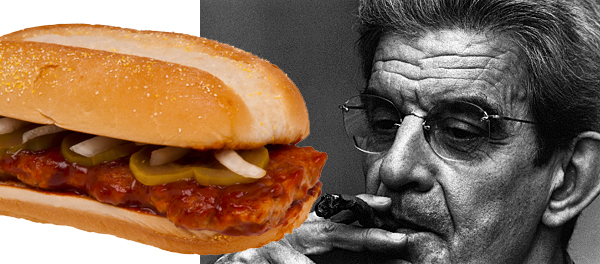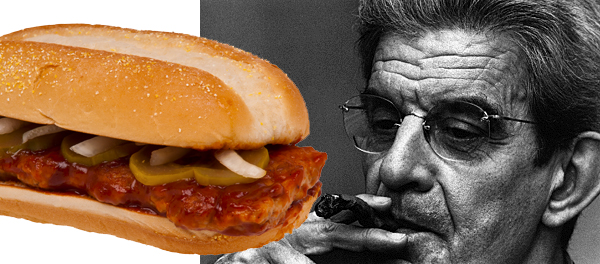Nothing quite calls for a little psychoanalysis like America’s obsession with disgusting food items. So I was delighted when Ian Bogost over at The Atlantic decided to explain Jacques Lacan’s concept of desire via McDonald’s McRib sandwich.
He starts by explaining Lacan’s notion of the objet a, for all those unfamiliar with Lacanian psychonalaysis.
Sometimes the things we believe aren’t out there in plain view, but hidden away inside. The French psychoanalyst Jacques Lacan gives the name objet a to the thing that elicits desire. In French the phrase means “object other” (the a stands for autre). For Lacan, our behaviors themselves may be knowable, but the causes of those behaviors aren’t always so. Objet a is not the object of desire (the thing we desire), but the thing that causes the desire to come into being (the cause of a desire for that thing). The philosopher Slavoj Žižek sometimes calls objet a the stain or defect in the world that motivates a belief or action…
The causes of our desires can’t be seen directly, but must be looked at from a distorted perspective. Žižek calls it a “parallax gap,” a break in perspective separating two things that cannot be synthesized. Here’s how he puts it: “the object-cause of desire is something that, when viewed frontally, is nothing at all, just a void—it acquires the contours of something only when viewed sideways.”
So what the hell does that have to do with the delicious pork-like product that I drunkenly devour?
We know that we do not know the composition of the McNugget or McRib or McWhatever, but we do not know precisely what it is that we do not know. Nevertheless, we desire such products not in spite of the fact that we do not know it, but because we don’t. This apparent paradox rests at the very heart of McDonald’s cookery: the secret components and methods that make it possible to create cheap and predictable, sweet and fat fast food. We normally don’t talk about it, but the chemical composition, mass-manufacture, and freezer-to-tray reconstitution of fast food isn’t just a convenient means to produce a result people enjoy. Instead, that very manufactured falseness is itself what we desire, in food as much as in smartphones—what is high-tech if not designed fakery?
Bogost argues that the McRib makes visible that “object-cause of desire for “McDonalds,” not the thing we desire, but the reason we desire that thing. We don’t eat the food itself, but “we consume the mechanical predictability of its overall offering.”
Lacan gave the name “symptom” to the process by which psychoanalytic subjects take part in their unconscious desires. Couldn’t one of Žižek’s famous refrains about the concept, “Enjoy your Symptom,” easily pass as a McDonald’s slogan? The strange, even upsetting relationship between McDonald’s and its customers is not so different from the analyst’s talking cure, which helps the patient see the symptom in order to allow it to be recognized and thereby to disappear. The McRib’s existence injects a measure of otherwise unrealizable gratification into the social fabric of food culture, like the McRib’s sauce covers reconstituted pork to make it palatable. Normally, psychoanalysis is meant to reveal a desire in order to satisfy it. But in the case of McRib, that satisfaction must be temporary, occasional, such that it can return again the next year. A good thing, too because who could bear it every day?
Yet, the McRib’s perversity is not a defect, but a feature. The purpose of the McRib is to make the McNugget seem normal.
Read the full article here.


